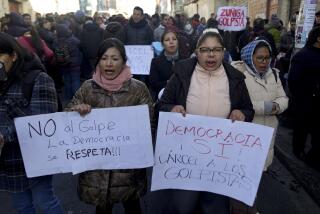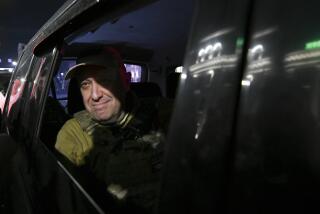NEWS ANALYSIS : Romania Facade Collapses in Riots : East Europe: The vigilante miners disappear from central streets, but the fear remains. Some see the violence as the product of a conspiracy.
- Share via
BUCHAREST, Romania — Soldiers and police patrolled the rain-pelted streets of Bucharest on Saturday after a violent uprising by unknown extremists and a brutal, chaotic crackdown that has given rise to speculation that the unrest was a product of conspiracy.
Thousands of grimy, club swinging miners who had terrorized the capital for two days disappeared from the central streets in the same manner they were called into action--by government appeal.
Railroad officials said the last trainload of miners left overnight. But in a nation where violence remains a conditioned response to insecurity, many fear the vigilantes could be back at the slightest provocation.
The preceding three days of rampaging that left six dead and more than 500 injured has collapsed Romania’s facade of a nation on the road to democracy and branded President Ion Iliescu, both at home and abroad, as a leader who will resort to ruthless tactics when threatened.
Yet as a result of the wave of violence, the president and the National Salvation Front he led to a landslide election victory retain a stronger rein on power in a nation now deprived of any organized political opposition.
The miners summoned to Bucharest by Iliescu after police and army troops failed to quell an anti-government riot on Wednesday trashed the headquarters and home of the leaders of the National Peasant and Liberal parties. The lawless mob beat pedestrians at random and shut down newspapers that had been critical of the front.
Prime Minister Petre Roman issued a faint slap on the wrist to the miners for what he said were “cases in which they acted in an uncontrolled manner and in which citizens were molested without reason.”
He defended the government action in mustering the mob as necessary to repel a coup attempt. Iliescu thanked the departing miners “with all my heart” for restoring order to the capital.
Roman and Iliescu both blamed unspecified fascist elements for instigating the Wednesday riots, in which protesters firebombed the Interior Ministry building and police headquarters and seized the national television station.
Police disappeared from the streets when the uprising grew to involve thousands, sowing suspicion that they were ordered to let the rioting get out of hand.
Roman heightened conspiracy fears when he told reporters Friday that the government was unaware of any orders to clear University Square of an anti-government sit-in that blocked traffic for 53 days.
Protesters in the demonstration that began April 22, originally organized by pacifists, wanted Iliescu and others banned from running in the elections because of their former membership in the Communist Party.
Roman said the police action of sweeping the square and arresting 263 was ordered by those attempting to destabilize his government, which casts suspicion on forces within the Interior Ministry that is responsible for police work.
Interior Minister Mihai Ghitac was fired Thursday, officially for the failure of his police force to contain the rioting.
One theory is that the police force was weakened because of the government’s attempt to weed out agents and supporters of the Securitate secret police force that brutally suppressed dissent during the 24-year dictatorship of Nicolae Ceausescu, who was toppled and executed during last December’s revolution.
Ghitac’s ministry was responsible for Securitate, and his continued presence in a ministerial role after the revolution had been viewed as evidence the Interior Ministry was not yet cleansed of the hated undercover force.
Some Western diplomats speculate that Ghitac may actually be a fall guy for a government-instigated riot provoked to provide a pretext for a harsh crackdown on political opponents.
The front--the target of their protracted demonstration--won a commanding 67% of the vote for parliamentary seats in the May 20 balloting, and Iliescu collected an 86% endorsement as head of state.
While the role of revolutionaries has been romanticized since the Romanian people’s success in ousting Ceausescu, front opponents could not have expected the public to rally behind their attempt to destabilize a government elected by such a large majority.
The question that remains open is who organized the rioting that broke out nearly 12 hours after the University Square sweep and who took part in the violence that led to Iliescu’s summons of the uncontrollable miners.
Iliescu and other government leaders who went on radio to call for help alluded to right-wing “fascist elements” and Gypsy mercenaries, stirring to life the fears and prejudices that run just beneath the surface of this troubled Balkan society.
Television footage of those who attacked the broadcast station showed rioters who were older than the students involved in University Square.
Some may have been Romanians driven to desperation by rising unemployment and persistent food shortages and the fear that nothing will change under the leadership of former Communists like Iliescu.
But the organized nature of the attack suggests an official hand was guiding the rioters.
Ion Ratiu, a millionaire emigre who returned earlier this year to run as the Peasant Party’s presidential candidate, speculated that Iliescu deliberately provoked the riots to have an excuse for reprisals against the opposition. Ratiu’s home was ransacked, and every item of value there or at the party’s headquarters was destroyed by the rampaging miners.
“If this is merely a rerun of the 1946 situation, that means simply the restoration of a Communist dictatorship,” Ratiu said, referring to the postwar crushing of all opposition forces.
If Iliescu truly saw the riot as a coup attempt, he may have called in the miners instead of police or army troops to avoid a large number of fatalities. While the miners’ actions were brutal and random, putting down the unrest with police and soldiers might have set off a more deadly exchange of gunfire.
The president blames right-wing forces in Romania and elsewhere in Europe for the attacks against the government, and Roman said foreign journalists gave “false presentation” of the unrest, revealing a sense of paranoia at the highest levels.
Iliescu also announced plans for a new national guard of “clean, loyal, honest people, who can act resolutely at exceptional times,” suggesting again that he distrusts both police and the army.
Another theory on the unrest is that it was instigated by the army to discredit Iliescu on the eve of his inauguration.
Iliescu’s swearing in as president was to have been Thursday, the morning after the riot.
The front has been under pressure from groups that helped stage the December revolution to prosecute officers and soldiers who fired on demonstrators during the revolt against Ceausescu.
Iliescu criticized the army for being slow to respond to last week’s rioting. According to witnesses, troops showed up only after midnight, when the first crowds of citizens had already arrived to defend the government sites.
Front spokesman Adrian Nastase said the army may have held back for fear of getting involved in a civil disorder, as soldiers now see themselves victimized for having followed orders to resist revolutionaries last December.
Asked if the army might have been involved in Wednesday’s revolt, Nastase replied, “I hope not.”
More to Read
Sign up for Essential California
The most important California stories and recommendations in your inbox every morning.
You may occasionally receive promotional content from the Los Angeles Times.














